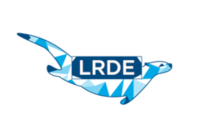CSI Seminar 2015-07-06
From LRDE

Spot
10h00 An efficient implementation of transition-based generalized Büchi automaton determinization – Alexandre Lewkowicz
Probabilistic model checkers usually rely on deterministic automata as the uniqueness of each path simplifies the probabilistic calculation. Unfortunatelythere are not many LTL translators that produce deterministic automata. Moreover, the automata produced by Spot, a model checker library, are not always deterministic. A classical powerset construction cannot always determinize '"`UNIQ--math-00000003-QINU`"'-automata. However, by memorizing the accepting paths, Safra's construction is able to convert a nondeterministic Büchi automaton into a deterministic Rabin automaton. This change of acceptance condition is necessary as deterministic Büchi automata are less expressive than the nondeterministic version. By implementing this construction, Spot will be able to determinize any automata and compute its complement. In this report, we will see how to efficiently implement the Safra construction and how to expand it to also determinize transition-based generalized Büchi automata.
Vcsn
10h30 New ways to use the Vcsn's Jupyter interface. – Nicolas Barray
Vcsn is a platform dedicated to the creation and manipulation of finite state automata and transducers, with or without multiplicity. It provides a fast and efficient C++ library and a Python 3 binding. It also comes with a web-based interface in Python 3 (Jupyter) to ease the more complex use of the C++ interface. The goal of this work is to add new straightforward and pedagogic ways to interact with the library by adding smart features to the web-based interface. The user shall naturally and quickly access to the whole feature of the platform such as creating automata with different algorithms or drag and drop style and applying other algorithm on newly-created automata.
11h00 Efficient removal of spontaneous transitions in Vcsn – Antoine Pietri
This report exposes some performant and generic ways to implement removal of spontaneous transitions in an '"`UNIQ--math-00000017-QINU`"'-NFA. We compare two different approches: the weighted '"`UNIQ--math-00000018-QINU`"'-closure algorithm of J. Sakarovitch and S. Lombardy, and the '"`UNIQ--math-00000019-QINU`"'-removal algorithm of M. Mohri. We discuss how these algorithm can be implemented when dealing with generic weighted automata, and their implications on performance by comparing some empirical results obtained in Vcsn.
11h30 Algorithms on Transducers – Valentin Tolmer
Transducers are used in many contexts, such as speech recognition or in order to measure the similarity between proteins. This research shows the implementation in Vcsn of several algorithms allowing to manipulate the transducersand thus solve these problems. First an algorithm to transform a transducer into a weighted automaton that can be easily evaluated is presented. The synchronization algorithm was then implemented, leading to the computation of the edit-distance transducer and its evaluation.
Speaker ID
12h00 Speaker Diarization based on Independent Component Analysis – Fanny Riols
During the last years, sound source separation has been a subject of intense research. In meetings or noisy public places, often a number of speakers are active simultaneously and the sources of interest need to be separated from interfering speech in order to be robustly recognized. An effective algorithm is the Independent Component Analysis (ICA). ICA models the mixture signal as a standard form of linear superposition of source signals. Under difficult environmental conditions, ICA outputs may still contain strong residual components of the interfering speakers. We will use this algorithm for speaker diarization in verification system. We will obtain better results especially in the case of multi-speaker audio datasuch as interview or microphone segment of NIST Speaker Recognition Evaluation.
Pause déjeuner: 12h30 - 14h
14h00 I-Vectors distance learning with Convolutional Neural Networks – Valentin Iovene
In this work we apply Convolutional Neural Networks to the task of speaker recognition. The CNN is used to approximate a measure of the distance between two i-vectors (representation of a speaker). Contrary to the commonly used cosine similarity measure, the function approximated by a CNN can be non-linear. The performance of this model will be compared to the ones of the Cosine Similarity measure and PLDA classification.
14h30 IVector space mapping with Deep Neural Network – Louis Groux
Building a robust speaker recognition system needs very slow and complex algorithms. In this work, we propose a deep neural network to map a low dimensionnal ivector space based on less complex model into high dimensional ivector space. The system will be evaluated on speaker recognition task of NIST-SRE 2010 data.
Olena
15h00 Image processing for plots detection from ancient maps – Anne-Claire Berthet
Morphological operators can be applied on grayscale images to filter out some objects or conversely to emphasize some objects. Therefore, by choosing an appropriate structuring element, it is possible to eliminate some elements of a map like text and to reconstruct discontinuous lines. A filter bench has been defined to extract from images of ancient maps the thin lines whatever their orientation, that isthe plot boundaries. On the resulting images, a watershed algorithm can afterwards segment the plots. Moreoverapplying a "seam carving" algorithm as pre-processing removes grid lines when needed.
15h30 Adaptation of the watershed cuts algorithm to cellular complexes – Guillaume Doré
The main purpose of the watershed algorithm is to segment a gray-level image into regions (basins). More specifically, the "watershed cut" algorithm performs some cuts in an edge-valued graph built from an image.First we have considered an image as a 4-connected graph, where the vertices represent the pixels. Yet we have noticed that this representation can miss some local minima. A second approach, based on a simplicial complex, has been studied. This work relies on Milena, the generic C++ library dedicated to image processing library developed at the LRDE.
